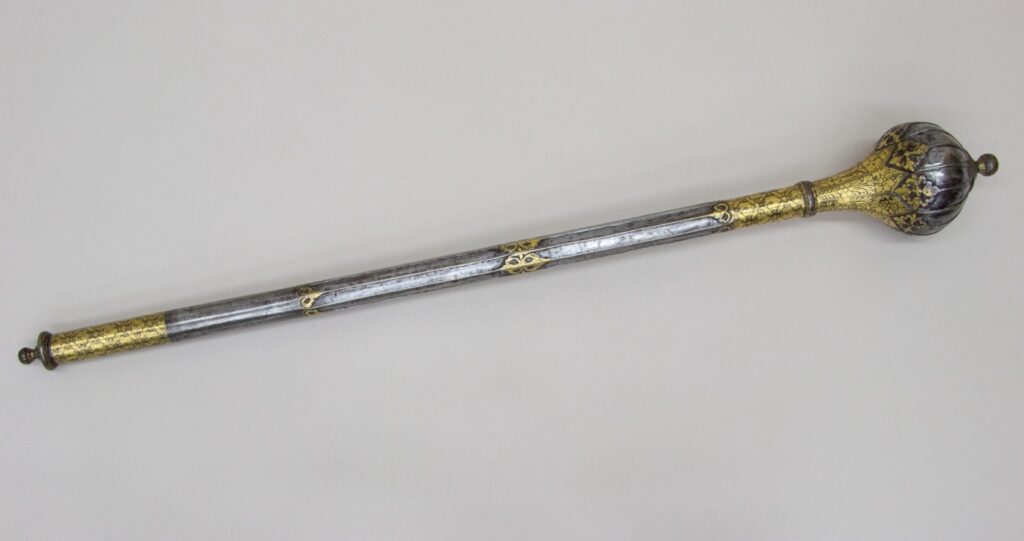
In the diverse tapestry of ancient Indian weaponry and fitness tools, one instrument stands out for its unique combination of historical significance, martial prowess, and contemporary fitness applications—the Gada. This article delves into the rich history, cultural relevance, traditional use, and modern adaptation of the Gada, shedding light on its enduring legacy in both combat and physical fitness.
The Gada, also known as the mace, traces its origins to ancient India, where it was initially developed as a weapon. Early Gada’s were simple, heavy clubs with a spherical head and a long, sturdy handle. Over time, these weapons evolved into more intricate and ornate designs, reflecting the region’s diverse kingdoms and cultures.
Gada combat, known as “Gada Yuddha” or “Gada Vidya,” became a distinct form of martial art, primarily practiced by Indian warriors and wrestlers. This combat technique involved wielding the Gada with precision and power, making it a formidable weapon on the battlefield.
The Gada holds significant symbolism in Hinduism, where it is associated with Lord Hanuman, the monkey god known for his strength and devotion. Hanuman is often depicted carrying a massive Gada, signifying his might and unwavering dedication.
Beyond its religious connotations, the Gada has played a pivotal role in Indian culture. It was featured in various forms of art, literature, and rituals, serving as a symbol of physical strength, valor, and discipline.
The traditional Gada workout is a demanding regimen that focuses on building strength, endurance, and agility. Wrestlers and warriors engaged in Gada training to prepare for combat and physical challenges.
Gada exercises typically involve a series of dynamic swinging and striking movements. Wrestlers would swing the Gada overhead, alternating between the left and right hands, enhancing their upper body strength and coordination.
Holding and controlling the Gada requires a powerful grip. Wrestlers would perform various exercises to strengthen their hand and forearm muscles, essential for grappling and wrestling opponents.
In recent years, the Gada has experienced a resurgence in popularity among fitness enthusiasts and athletes. Its effectiveness in developing strength, flexibility, and endurance has drawn individuals from various disciplines, including weightlifting, CrossFit, and functional fitness.
Modern Gada training has adapted the traditional techniques to suit contemporary fitness goals. Gyms and fitness centers offer Gada-inspired workouts, incorporating the mace as a versatile fitness tool.
V. How to Start Gada Training
Before beginning Gada training, it’s crucial to prioritize safety. Choose an appropriate weight for your fitness level, and always warm up and stretch before starting your routine.
If you’re new to Gada training, consider seeking guidance from a certified instructor or experienced practitioner who can teach you proper techniques and ensure that you’re using correct form to prevent injuries.
Gadas come in various weights and styles. Beginners should opt for a lighter Gada to become familiar with the movements before progressing to heavier ones.
Start with basic Gada movements, such as overhead swings and lateral swings. Focus on mastering these fundamental techniques before attempting more complex exercises.
As your strength and proficiency increase, you can gradually incorporate more challenging Gada exercises and routines into your training.
The Gada, born from the crucible of ancient Indian warfare and culture, continues to leave an indelible mark on the world of fitness and physical conditioning. Its history as a formidable weapon and its role in Indian tradition and religion lend it a unique and enduring significance.
Today, as fitness enthusiasts and athletes seek effective and diverse training methods, the Gada’s resurgence is a testament to its enduring relevance. By incorporating this ancient tool into their routines, individuals can not only build strength and endurance but also connect with a rich cultural heritage that celebrates discipline, dedication, and physical prowess.
Whether one’s interest lies in historical weaponry, spiritual symbolism, or modern fitness, the Gada offers a captivating journey into the heart of India’s multifaceted heritage—one that continues to inspire and empower individuals on their quest for physical and mental well-being.